[English] 日本語
 Yorodumi
Yorodumi- PDB-7lfr: Crystal structure of the epidermal growth factor receptor extrace... -
+ Open data
Open data
- Basic information
Basic information
| Entry | Database: PDB / ID: 7lfr | ||||||
|---|---|---|---|---|---|---|---|
| Title | Crystal structure of the epidermal growth factor receptor extracellular region with R84K mutation in complex with epiregulin crystallized with spermine | ||||||
 Components Components |
| ||||||
 Keywords Keywords |  SIGNALING PROTEIN / SIGNALING PROTEIN /  receptor / receptor /  epiregulin / epiregulin /  glioblastoma / glioblastoma /  cancer / cancer /  mutation / mutation /  extracellular / asymmetric / dimer / extracellular / asymmetric / dimer /  ErbB1 / EGFR ErbB1 / EGFR | ||||||
| Function / homology |  Function and homology information Function and homology informationluteinizing hormone signaling pathway / ovarian cumulus expansion /  ovulation / ERBB4-ERBB4 signaling pathway / negative regulation of smooth muscle cell differentiation / ERBB2-ERBB4 signaling pathway / primary follicle stage / female meiotic nuclear division / PI3K events in ERBB4 signaling / positive regulation of innate immune response ...luteinizing hormone signaling pathway / ovarian cumulus expansion / ovulation / ERBB4-ERBB4 signaling pathway / negative regulation of smooth muscle cell differentiation / ERBB2-ERBB4 signaling pathway / primary follicle stage / female meiotic nuclear division / PI3K events in ERBB4 signaling / positive regulation of innate immune response ...luteinizing hormone signaling pathway / ovarian cumulus expansion /  ovulation / ERBB4-ERBB4 signaling pathway / negative regulation of smooth muscle cell differentiation / ERBB2-ERBB4 signaling pathway / primary follicle stage / female meiotic nuclear division / PI3K events in ERBB4 signaling / positive regulation of innate immune response / response to hydroxyisoflavone / ovulation / ERBB4-ERBB4 signaling pathway / negative regulation of smooth muscle cell differentiation / ERBB2-ERBB4 signaling pathway / primary follicle stage / female meiotic nuclear division / PI3K events in ERBB4 signaling / positive regulation of innate immune response / response to hydroxyisoflavone /  multivesicular body, internal vesicle lumen / positive regulation of prolactin secretion / negative regulation of cardiocyte differentiation / positive regulation of protein kinase C activity / multivesicular body, internal vesicle lumen / positive regulation of prolactin secretion / negative regulation of cardiocyte differentiation / positive regulation of protein kinase C activity /  mRNA transcription / mRNA transcription /  oocyte maturation / diterpenoid metabolic process / Shc-EGFR complex / oocyte maturation / diterpenoid metabolic process / Shc-EGFR complex /  ovulation cycle / Inhibition of Signaling by Overexpressed EGFR / ovulation cycle / Inhibition of Signaling by Overexpressed EGFR /  epidermal growth factor receptor activity / EGFR interacts with phospholipase C-gamma / positive regulation of mucus secretion / response to UV-A / epidermal growth factor receptor activity / EGFR interacts with phospholipase C-gamma / positive regulation of mucus secretion / response to UV-A /  epidermal growth factor binding / PLCG1 events in ERBB2 signaling / tongue development / midgut development / ERBB2-EGFR signaling pathway / hydrogen peroxide metabolic process / PTK6 promotes HIF1A stabilization / digestive tract morphogenesis / epidermal growth factor binding / PLCG1 events in ERBB2 signaling / tongue development / midgut development / ERBB2-EGFR signaling pathway / hydrogen peroxide metabolic process / PTK6 promotes HIF1A stabilization / digestive tract morphogenesis /  regulation of nitric-oxide synthase activity / regulation of nitric-oxide synthase activity /  epidermal growth factor receptor binding / morphogenesis of an epithelial fold / ERBB2 Activates PTK6 Signaling / intracellular vesicle / Signaling by EGFR / response to cobalamin / epidermal growth factor receptor binding / morphogenesis of an epithelial fold / ERBB2 Activates PTK6 Signaling / intracellular vesicle / Signaling by EGFR / response to cobalamin /  transmembrane receptor protein tyrosine kinase activator activity / protein tyrosine kinase activator activity / negative regulation of epidermal growth factor receptor signaling pathway / Signaling by ERBB4 / regulation of phosphatidylinositol 3-kinase/protein kinase B signal transduction / eyelid development in camera-type eye / protein insertion into membrane / cerebral cortex cell migration / ERBB2 Regulates Cell Motility / regulation of JNK cascade / positive regulation of cell division / : / PI3K events in ERBB2 signaling / positive regulation of cyclin-dependent protein serine/threonine kinase activity / keratinocyte proliferation / negative regulation of mitotic cell cycle / hair follicle development / SHC1 events in ERBB4 signaling / transmembrane receptor protein tyrosine kinase activator activity / protein tyrosine kinase activator activity / negative regulation of epidermal growth factor receptor signaling pathway / Signaling by ERBB4 / regulation of phosphatidylinositol 3-kinase/protein kinase B signal transduction / eyelid development in camera-type eye / protein insertion into membrane / cerebral cortex cell migration / ERBB2 Regulates Cell Motility / regulation of JNK cascade / positive regulation of cell division / : / PI3K events in ERBB2 signaling / positive regulation of cyclin-dependent protein serine/threonine kinase activity / keratinocyte proliferation / negative regulation of mitotic cell cycle / hair follicle development / SHC1 events in ERBB4 signaling /  MAP kinase kinase kinase activity / Estrogen-dependent nuclear events downstream of ESR-membrane signaling / anatomical structure morphogenesis / embryonic placenta development / positive regulation of protein kinase activity / positive regulation of bone resorption / positive regulation of G1/S transition of mitotic cell cycle / GAB1 signalosome / positive regulation of nitric oxide mediated signal transduction / salivary gland morphogenesis / peptidyl-tyrosine autophosphorylation / Nuclear signaling by ERBB4 / regulation of peptidyl-tyrosine phosphorylation / positive regulation of phosphorylation / positive regulation of glial cell proliferation / keratinocyte differentiation / positive regulation of vasoconstriction / Signaling by ERBB2 / cellular response to epidermal growth factor stimulus / cellular response to cadmium ion / GRB2 events in EGFR signaling / SHC1 events in EGFR signaling / positive regulation of DNA repair / EGFR Transactivation by Gastrin / GRB2 events in ERBB2 signaling / TFAP2 (AP-2) family regulates transcription of growth factors and their receptors / MAP kinase kinase kinase activity / Estrogen-dependent nuclear events downstream of ESR-membrane signaling / anatomical structure morphogenesis / embryonic placenta development / positive regulation of protein kinase activity / positive regulation of bone resorption / positive regulation of G1/S transition of mitotic cell cycle / GAB1 signalosome / positive regulation of nitric oxide mediated signal transduction / salivary gland morphogenesis / peptidyl-tyrosine autophosphorylation / Nuclear signaling by ERBB4 / regulation of peptidyl-tyrosine phosphorylation / positive regulation of phosphorylation / positive regulation of glial cell proliferation / keratinocyte differentiation / positive regulation of vasoconstriction / Signaling by ERBB2 / cellular response to epidermal growth factor stimulus / cellular response to cadmium ion / GRB2 events in EGFR signaling / SHC1 events in EGFR signaling / positive regulation of DNA repair / EGFR Transactivation by Gastrin / GRB2 events in ERBB2 signaling / TFAP2 (AP-2) family regulates transcription of growth factors and their receptors /  transmembrane receptor protein tyrosine kinase activity / SHC1 events in ERBB2 signaling / transmembrane receptor protein tyrosine kinase activity / SHC1 events in ERBB2 signaling /  ossification / positive regulation of mitotic nuclear division / positive regulation of synaptic transmission, glutamatergic / ossification / positive regulation of mitotic nuclear division / positive regulation of synaptic transmission, glutamatergic /  neurogenesis / cellular response to dexamethasone stimulus / basal plasma membrane / regulation of ERK1 and ERK2 cascade / neuron projection morphogenesis / positive regulation of superoxide anion generation / positive regulation of DNA replication / Signal transduction by L1 / epithelial cell proliferation / positive regulation of cytokine production / cellular response to estradiol stimulus neurogenesis / cellular response to dexamethasone stimulus / basal plasma membrane / regulation of ERK1 and ERK2 cascade / neuron projection morphogenesis / positive regulation of superoxide anion generation / positive regulation of DNA replication / Signal transduction by L1 / epithelial cell proliferation / positive regulation of cytokine production / cellular response to estradiol stimulusSimilarity search - Function | ||||||
| Biological species |   Homo sapiens (human) Homo sapiens (human) | ||||||
| Method |  X-RAY DIFFRACTION / X-RAY DIFFRACTION /  SYNCHROTRON / SYNCHROTRON /  MOLECULAR REPLACEMENT / Resolution: 3.2 Å MOLECULAR REPLACEMENT / Resolution: 3.2 Å | ||||||
 Authors Authors | Hu, C. / Leche II, C.A. / Stayrook, S.E. / Ferguson, K.M. / Lemmon, M.A. | ||||||
| Funding support |  United States, 1items United States, 1items
| ||||||
 Citation Citation |  Journal: Nature / Year: 2022 Journal: Nature / Year: 2022Title: Glioblastoma mutations alter EGFR dimer structure to prevent ligand bias. Authors: Hu, C. / Leche 2nd, C.A. / Kiyatkin, A. / Yu, Z. / Stayrook, S.E. / Ferguson, K.M. / Lemmon, M.A. | ||||||
| History |
|
- Structure visualization
Structure visualization
| Structure viewer | Molecule:  Molmil Molmil Jmol/JSmol Jmol/JSmol |
|---|
- Downloads & links
Downloads & links
- Download
Download
| PDBx/mmCIF format |  7lfr.cif.gz 7lfr.cif.gz | 223.1 KB | Display |  PDBx/mmCIF format PDBx/mmCIF format |
|---|---|---|---|---|
| PDB format |  pdb7lfr.ent.gz pdb7lfr.ent.gz | 176.1 KB | Display |  PDB format PDB format |
| PDBx/mmJSON format |  7lfr.json.gz 7lfr.json.gz | Tree view |  PDBx/mmJSON format PDBx/mmJSON format | |
| Others |  Other downloads Other downloads |
-Validation report
| Arichive directory |  https://data.pdbj.org/pub/pdb/validation_reports/lf/7lfr https://data.pdbj.org/pub/pdb/validation_reports/lf/7lfr ftp://data.pdbj.org/pub/pdb/validation_reports/lf/7lfr ftp://data.pdbj.org/pub/pdb/validation_reports/lf/7lfr | HTTPS FTP |
|---|
-Related structure data
| Related structure data | 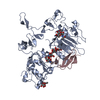 7lenC 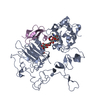 7lfsC 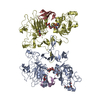 5wb7S C: citing same article ( S: Starting model for refinement |
|---|---|
| Similar structure data |
- Links
Links
- Assembly
Assembly
| Deposited unit | 
| ||||||||
|---|---|---|---|---|---|---|---|---|---|
| 1 |
| ||||||||
| 2 | 
| ||||||||
| 3 | 
| ||||||||
| Unit cell |
|
- Components
Components
-Protein / Protein/peptide , 2 types, 4 molecules ABCD
| #1: Protein |  / Proto-oncogene c-ErbB-1 / Receptor tyrosine-protein kinase erbB-1 / Proto-oncogene c-ErbB-1 / Receptor tyrosine-protein kinase erbB-1Mass: 55803.461 Da / Num. of mol.: 2 / Mutation: R84K Source method: isolated from a genetically manipulated source Source: (gene. exp.)   Homo sapiens (human) / Gene: EGFR, ERBB, ERBB1, HER1 / Production host: Homo sapiens (human) / Gene: EGFR, ERBB, ERBB1, HER1 / Production host:   Spodoptera frugiperda (fall armyworm) Spodoptera frugiperda (fall armyworm)References: UniProt: P00533,  receptor protein-tyrosine kinase receptor protein-tyrosine kinase#2: Protein/peptide | Mass: 5480.307 Da / Num. of mol.: 2 Source method: isolated from a genetically manipulated source Source: (gene. exp.)   Homo sapiens (human) / Gene: EREG / Production host: Homo sapiens (human) / Gene: EREG / Production host:   Drosophila melanogaster (fruit fly) / References: UniProt: O14944 Drosophila melanogaster (fruit fly) / References: UniProt: O14944 |
|---|
-Sugars , 4 types, 9 molecules 
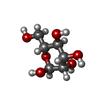
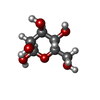


| #3: Polysaccharide | beta-D-mannopyranose-(1-4)-2-acetamido-2-deoxy-beta-D-glucopyranose / Mass: 383.349 Da / Num. of mol.: 1 / Source method: obtained synthetically / Mass: 383.349 Da / Num. of mol.: 1 / Source method: obtained synthetically | ||||
|---|---|---|---|---|---|
| #4: Sugar | ChemComp-NAG /  N-Acetylglucosamine N-Acetylglucosamine#5: Sugar |  Mannose Mannose#6: Sugar | ChemComp-BMA / |  Mannose Mannose |
-Details
| Has ligand of interest | N |
|---|
-Experimental details
-Experiment
| Experiment | Method:  X-RAY DIFFRACTION / Number of used crystals: 1 X-RAY DIFFRACTION / Number of used crystals: 1 |
|---|
- Sample preparation
Sample preparation
| Crystal | Density Matthews: 2.64 Å3/Da / Density % sol: 53 % |
|---|---|
Crystal grow | Temperature: 293.15 K / Method: vapor diffusion, hanging drop / pH: 7.5 Details: 8 mg/ml protein, 100 mM HEPES (pH 7.5), 12% PEG3350, 10 mM spermine tetrahydrochloride |
-Data collection
| Diffraction | Mean temperature: 100 K / Serial crystal experiment: N | |||||||||||||||||||||||||||||||||||||||||||||||||||||||||||||||||||||||||||||||||||||||||||||||||||||||||||||||||||||||||
|---|---|---|---|---|---|---|---|---|---|---|---|---|---|---|---|---|---|---|---|---|---|---|---|---|---|---|---|---|---|---|---|---|---|---|---|---|---|---|---|---|---|---|---|---|---|---|---|---|---|---|---|---|---|---|---|---|---|---|---|---|---|---|---|---|---|---|---|---|---|---|---|---|---|---|---|---|---|---|---|---|---|---|---|---|---|---|---|---|---|---|---|---|---|---|---|---|---|---|---|---|---|---|---|---|---|---|---|---|---|---|---|---|---|---|---|---|---|---|---|---|---|---|
| Diffraction source | Source:  SYNCHROTRON / Site: SYNCHROTRON / Site:  APS APS  / Beamline: 23-ID-B / Wavelength: 1.0332 Å / Beamline: 23-ID-B / Wavelength: 1.0332 Å | |||||||||||||||||||||||||||||||||||||||||||||||||||||||||||||||||||||||||||||||||||||||||||||||||||||||||||||||||||||||||
| Detector | Type: DECTRIS EIGER X 16M / Detector: PIXEL / Date: Feb 14, 2020 / Details: Undulator | |||||||||||||||||||||||||||||||||||||||||||||||||||||||||||||||||||||||||||||||||||||||||||||||||||||||||||||||||||||||||
| Radiation | Protocol: SINGLE WAVELENGTH / Monochromatic (M) / Laue (L): M / Scattering type: x-ray | |||||||||||||||||||||||||||||||||||||||||||||||||||||||||||||||||||||||||||||||||||||||||||||||||||||||||||||||||||||||||
| Radiation wavelength | Wavelength : 1.0332 Å / Relative weight: 1 : 1.0332 Å / Relative weight: 1 | |||||||||||||||||||||||||||||||||||||||||||||||||||||||||||||||||||||||||||||||||||||||||||||||||||||||||||||||||||||||||
| Reflection | Resolution: 3.2→99.006 Å / Num. obs: 22984 / % possible obs: 99.8 % / Redundancy: 8.4 % / Rpim(I) all: 0.073 / Rrim(I) all: 0.215 / Rsym value: 0.202 / Net I/av σ(I): 3.1 / Net I/σ(I): 9 / Num. measured all: 193914 | |||||||||||||||||||||||||||||||||||||||||||||||||||||||||||||||||||||||||||||||||||||||||||||||||||||||||||||||||||||||||
| Reflection shell | Diffraction-ID: 1
|
- Processing
Processing
| Software |
| |||||||||||||||||||||||||||||||||||||||||||||||||||||||||||||||
|---|---|---|---|---|---|---|---|---|---|---|---|---|---|---|---|---|---|---|---|---|---|---|---|---|---|---|---|---|---|---|---|---|---|---|---|---|---|---|---|---|---|---|---|---|---|---|---|---|---|---|---|---|---|---|---|---|---|---|---|---|---|---|---|---|
| Refinement | Method to determine structure : :  MOLECULAR REPLACEMENT MOLECULAR REPLACEMENTStarting model: 5WB7 Resolution: 3.2→43.6 Å / SU ML: 0.47 / Cross valid method: THROUGHOUT / σ(F): 1.34 / Phase error: 30.43 / Stereochemistry target values: ML
| |||||||||||||||||||||||||||||||||||||||||||||||||||||||||||||||
| Solvent computation | Shrinkage radii: 0.9 Å / VDW probe radii: 1.11 Å / Solvent model: FLAT BULK SOLVENT MODEL | |||||||||||||||||||||||||||||||||||||||||||||||||||||||||||||||
| Displacement parameters | Biso max: 170.45 Å2 / Biso mean: 92.041 Å2 / Biso min: 40.83 Å2 | |||||||||||||||||||||||||||||||||||||||||||||||||||||||||||||||
| Refinement step | Cycle: final / Resolution: 3.2→43.6 Å
| |||||||||||||||||||||||||||||||||||||||||||||||||||||||||||||||
| LS refinement shell | Refine-ID: X-RAY DIFFRACTION / Rfactor Rfree error: 0 / Total num. of bins used: 8
|
 Movie
Movie Controller
Controller



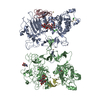

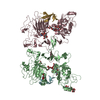
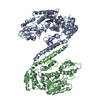

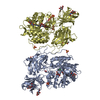
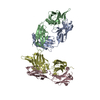
 PDBj
PDBj



















